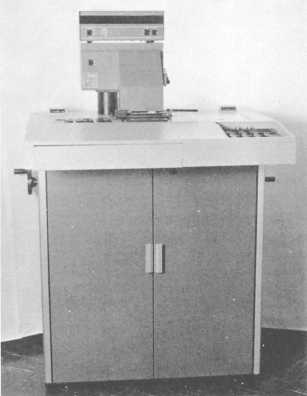The principles of making color positive prints from
color transparencies are the same whether coupler
development or dye destruction materials are used.
Colored filters are used to alter the printing light to
obtain proper color balance, much the same as is done
in printing color negatives.
You must keep in mind, however, that you are
working with color positive materials, and not negative
materials. The borders of these positive materials are
black when unexposed. Dust particles and scratches also
appear black. To make a test print lighter, you must
increase the exposure. Dodging darkens selective areas
of a print, and burning in lightens selective areas of a
print. Color corrections are performed the same as the
visual appearance requires.
AUTOMATED PRINTERS
Many Navy imaging facilities have automated
printers that print photographic negatives. Most can be
used to print both black and white and color. When
high-volume production is routine in an imaging
facility, automated printers are an invaluable piece of
equipment.
There are many types of automated printers
throughout the fleet. Some types hold long rolls of
photographic paper that must be taken out and processed
through a processor. Other more sophisticated types
analyze, expose, cut, process, and dry the paper auto-
matically.
ROLL PAPER PRINTERS
The roll paper printer is very popular on larger ships
and shore stations that produce a large volume of color
prints. The advantages of roll paper printers are they are
operated under normal room lighting conditions, and
they are very useful when a large number of the same
size prints are needed from a single negative. When
these printers are used, the correct density and color is
accomplished by making test prints. Once the
corrections and number of prints required are keyed into
the printer, the printer makes each exposure and
advances the paper automatically. When the printing is
completed, the exposed roll of paper is removed and
processed. After processing, the prints are then cut from
the roll with a paper cutter.
Roll paper printers have built-in analyzers. These
analyzers are calibrated using standard negatives. When
a production negative is printed, the machine refers to
the memory and produces a print using the information
stored from the standard negative. Generally, that
produces a print that closely represents the original
PH1 Slaughenhaupt
302.263
Figure 12-7A.–Front view of Pako BC 24 roll paper printer.
scene; however, test prints are still made to produce the
highest quality prints possible. The most popular roll
paper printer used in Navy imaging facilities is the Pako
BC 24 (fig. 12-7A and fig. 12-7B).
MINILAB SYSTEMS
Minilab systems (fig. 12-8) have become very
popular in Navy imaging shore facilities and aircraft
carriers. These types of printers are fast and can be used
to rush production. In these systems, the printer and
processor are combined into one unit. The printer cuts
the paper to size, exposes it, and automatically feeds it
through the processor. Minilabs (as they are called) are
used in all of the “One Hour” photo-finishing shops that
you see today.
The operation of a minilab is very easy once you
become familiar with the system. Minilabs can be
operated under normal room lighting conditions. The
printer is controlled by a keyboard (fig. 12-9). Some
systems have zoom enlarging lenses to alter the image
size. The negative can be aligned and composed by
adjusting the negative carrier. These adjustments to the
image size and cropping can be seen on a viewing
screen.
12-15



